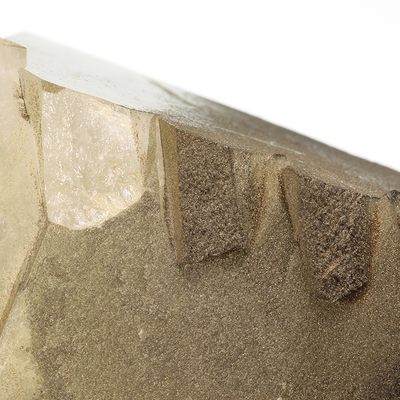As recorded:
Ägene Valley, Ulrichen, Obergoms, Goms, Valais, Switzerland
10.3cm x 5.7cm x 4.8cm

Photo added to mindat.org
“10.3 x 5.7 x 4.8 cm
A classic example of the famous adularia twins from Switzerland. This piece is a large, sharp, thick, well-formed, beautifully twinned crystal that I would classify as being a "near floater" as it's crystallized nearly all the way around, but there is a spot on the base that keep it from being 100% pristine. This is a Baveno twin and looks fantastic from all angles. There is no "front" side, as each angle makes its case for being the "display" side of the crystal. Whether you like the defined twinning line on one side, or the rigid "teeth" flaring out of the sides seen on another angle, the piece presents something different every 90 degrees in which it's turned. For years, adularia was defined as a variety of orthoclase, but now it's defined as a variety of either orthoclase or microcline depending upon the habit (monoclinic or triclinic). The rich moss-green color is due to inclusions of "chlorite", which have created a lovely two-tone crystal. This is a fairly large twinned adularia from any locality.
”
Brian Kosnar - 26th February 2019

Photo added to mindat.org
“10.3 x 5.7 x 4.8 cm
A classic example of the famous adularia twins from Switzerland. This piece is a large, sharp, thick, well-formed, beautifully twinned crystal that I would classify as being a "near floater" as it's crystallized nearly all the way around, but there is a spot on the base that keep it from being 100% pristine. This is a Baveno twin and looks fantastic from all angles. There is no "front" side, as each angle makes its case for being the "display" side of the crystal. Whether you like the defined twinning line on one side, or the rigid "teeth" flaring out of the sides seen on another angle, the piece presents something different every 90 degrees in which it's turned. For years, adularia was defined as a variety of orthoclase, but now it's defined as a variety of either orthoclase or microcline depending upon the habit (monoclinic or triclinic). The rich moss-green color is due to inclusions of "chlorite", which have created a lovely two-tone crystal. This is a fairly large twinned adularia from any locality.
”
Brian Kosnar - 26th February 2019

Photo added to mindat.org
“10.3 x 5.7 x 4.8 cm
A classic example of the famous adularia twins from Switzerland. This piece is a large, sharp, thick, well-formed, beautifully twinned crystal that I would classify as being a "near floater" as it's crystallized nearly all the way around, but there is a spot on the base that keep it from being 100% pristine. This is a Baveno twin and looks fantastic from all angles. There is no "front" side, as each angle makes its case for being the "display" side of the crystal. Whether you like the defined twinning line on one side, or the rigid "teeth" flaring out of the sides seen on another angle, the piece presents something different every 90 degrees in which it's turned. For years, adularia was defined as a variety of orthoclase, but now it's defined as a variety of either orthoclase or microcline depending upon the habit (monoclinic or triclinic). The rich moss-green color is due to inclusions of "chlorite", which have created a lovely two-tone crystal. This is a fairly large twinned adularia from any locality.
”
Brian Kosnar - 26th February 2019

Photo added to mindat.org
“10.3 x 5.7 x 4.8 cm
A classic example of the famous adularia twins from Switzerland. This piece is a large, sharp, thick, well-formed, beautifully twinned crystal that I would classify as being a "near floater" as it's crystallized nearly all the way around, but there is a spot on the base that keep it from being 100% pristine. This is a Baveno twin and looks fantastic from all angles. There is no "front" side, as each angle makes its case for being the "display" side of the crystal. Whether you like the defined twinning line on one side, or the rigid "teeth" flaring out of the sides seen on another angle, the piece presents something different every 90 degrees in which it's turned. For years, adularia was defined as a variety of orthoclase, but now it's defined as a variety of either orthoclase or microcline depending upon the habit (monoclinic or triclinic). The rich moss-green color is due to inclusions of "chlorite", which have created a lovely two-tone crystal. This is a fairly large twinned adularia from any locality.
”
Brian Kosnar - 26th February 2019
No-one has added this to their favourites.
10,444,595 minIDs have been issued as of 3rd May 2024 9:09 am UTC
